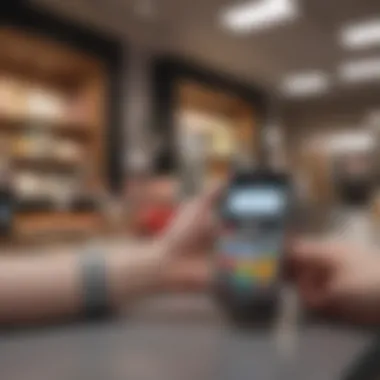Explore Top Retailers That Accept Apple Pay Today


Intro
In an era where digital payments are becoming the norm, knowing where and how to use Apple Pay can significantly enhance your shopping experience. This guide delves into the various retail locations and online platforms that accept Apple Pay, outlining its benefits and practicality for daily transactions. With a focus on authenticity and usability, this article aims to inform both Apple enthusiasts and the general public about the effectiveness of Apple Pay in various contexts.
One of the primary motivations behind the growing adoption of Apple Pay is its security. By utilizing tokenization and biometric verification, users can transact with reassurance that their information is protected. Furthermore, the convenience of using Apple’s ecosystem allows for seamless integration between devices, paving the way for a new era of cashless transactions.
Knowing where Apple Pay is accepted helps users utilize this technology fully. Whether in store or online, understanding its reach and functionality can empower consumers to make informed choices in their shopping endeavors.
Understanding Apple Pay
Understanding Apple Pay is essential for consumers who want a fast and secure way to pay. As digital payments evolve, Apple Pay presents a seamless option. It combines convenience with advanced technology to create a user-friendly experience for both in-person and online transactions.
What is Apple Pay?
Apple Pay is a digital wallet service provided by Apple Inc. It allows users to make payments using their iPhone, iPad, or Apple Watch. This service is designed to replace traditional card-based transactions, offering a more efficient and secure method of payment. Apple Pay uses Near Field Communication (NFC) technology, which enables devices to communicate with payment terminals.
The platform supports several payment types, including in-store purchases, app payments, and ticketing. Completing a transaction is simple. Users authenticate with Face ID, Touch ID, or their passcode, which adds an extra layer of security. This ensures only the owner can approve payments with their device.
How Does Apple Pay Work?
Apple Pay works by linking your credit or debit card to the Wallet app on your Apple device. Here are the steps needed to use Apple Pay:
- Add a Card: Users can add their card information directly into the Wallet app. The system verifies the information with the bank to ensure validity.
- Payment Process: When making a purchase, users must hold their device near the payment terminal. The transaction is initiated using NFC technology, often requiring user authentication at the time of payment.
- Secure Tokenization: Instead of using your actual card number, Apple Pay generates a unique, encrypted token for the transaction. This means your sensitive data is not shared, enhancing security for users.
Overall, the process is quick and efficient, eliminating the need to fumble with cash or cards at checkout.
Benefits of Using Apple Pay
Using Apple Pay comes with various advantages:
- Convenience: Users can complete transactions quickly. Just double-click the side button and hold the device near the terminal.
- Security: Apple Pay provides enhanced security features. The use of tokenization and biometric authentication makes it risk-free.
- Privacy: Purchases made with Apple Pay are private. Your actual credit or debit card numbers are never shared with merchants.
- Support for Multiple Cards: Users can store multiple payment methods in the Wallet app, providing flexibility when shopping.
- Wide Acceptance: Apple Pay is accepted at many major retailers, grocery stores, and even online platforms, making it a versatile option for consumers.
Retail Stores That Accept Apple Pay
The adoption of Apple Pay by various retail stores has facilitated a seamless payment experience for consumers. This convenience is vital today, where consumer preferences are oriented towards fast and secure transactions. The significance of knowing which retail stores accept Apple Pay cannot be understated; it allows individuals to plan their shopping effectively and enjoy the benefits associated with contactless payments.
Grocery Stores
Grocery stores have increasingly embraced Apple Pay, reflecting the need for quick and efficient transactions. Many shoppers find using Apple Pay beneficial for several reasons. First, it allows them to check out without fumbling for cash or cards. Stores like Whole Foods and Publix enable customers to use their mobile devices to finalize purchases swiftly. This not only saves time but also enhances the shopping experience.
Furthermore, grocery shopping often involves carrying bags and managing a shopping cart. By utilizing Apple Pay, customers avoid unnecessary contact with products, contributing to a safer shopping environment, especially during times of health concerns.


Department Stores
Department stores offer a wide range of products, from clothing to home goods. Establishments such as Macy's and Nordstrom have adopted Apple Pay, allowing customers to make large purchases painlessly. The presence of Apple Pay in department stores signifies the evolution of retail transactions.
Being able to pay with a smartphone facilitates a more flexible shopping scenario. Customers can browse and buy without the limitations imposed by traditional payment methods. This modern approach reflects consumer demands for versatility, especially in settings with diverse product offerings.
Fashion Retailers
For fashion retailers, offering Apple Pay can draw in tech-savvy consumers who appreciate convenience. Stores such as H&M and Zara recognize that the fashion industry is highly competitive. By integrating Apple Pay into their payment processes, they set themselves apart. The fashion industry often targets young consumers who value speed and efficiency when making purchases.
Using Apple Pay allows for immediate transactions, reducing the chance of shopping cart abandonment. This capability is critical in influencing purchasing decisions in-store and online.
Electronics Stores
Electronics stores, including Best Buy and Apple Stores themselves, cater to a customer base that prioritizes advanced technology. Integrating a payment method like Apple Pay complements the products they sell. Shoppers purchasing expensive electronics benefit from the added security of transactions put through Apple Pay.
Moreover, it makes large transactions easier and more secure. The integration of Apple Pay reinforces the credibility of electronics stores, showing that they keep pace with modern payment trends and customer preferences.
Pharmacies and Health Stores
Pharmacies such as CVS and Walgreens have begun accepting Apple Pay, making it easier for customers to access essential health products. This is particularly useful when individuals need to make quick purchases without extensive delays. In pharmacies, discretion can be a priority, and using Apple Pay affords customers privacy when checking out.
The adoption signals a broader trend toward simplifying health transactions, allowing for seamless purchases without unnecessary physical contact or prolonged checkout times.
Fast Food Chains
Fast food chains, like McDonald's and Wendy's, have quickly adopted Apple Pay to meet consumer demand for speed. Quick-service environments thrive on efficiency, and Apple Pay addresses that need head-on. With the fast-paced lifestyle most people lead, being able to transact effortlessly makes these establishments more attractive.
Not only does it accelerate the payment process, but it also aligns with a growing trend toward contactless dining experiences. This, in turn, enhances consumer satisfaction.
Coffee Shops
Finally, coffee shops such as Starbucks and Dunkin' Donuts have recognized the importance of Apple Pay in daily consumer habits. Many coffee lovers want their drinks fast and without hassle. Apple Pay enables them to place orders and pay quickly, optimizing their morning routines.
Additionally, coffee shops often see repeat customers who prefer to use a consistent payment method. This convenience further solidifies customer loyalty and encourages repeat business.
In summary, the increasing use of Apple Pay across various retail formats demonstrates its widespread acceptance and utility. As shopping habits shift, it becomes crucial for retailers to incorporate flexible, user-friendly payment methods to stay relevant.
Online Retail Platforms Accepting Apple Pay
As digital transactions continue to gain momentum, the significance of online retail platforms accepting Apple Pay is paramount. This payment solution enhances convenience and security for customers shopping online. As a widely used mobile payment system, Apple Pay allows for seamless transactions, easing checkout processes on various websites. The adoption of Apple Pay by renowned online retailers can influence consumer choices, as users prioritize secure and efficient payment methods. In this section, we explore notable sectors where Apple Pay is integrated into the shopping experience, reflecting both trends and user preferences.
E-commerce Giants


E-commerce giants such as Amazon, eBay, and Walmart have recognized the benefits of incorporating Apple Pay. These platforms provide customers with a quick and secure checkout process. By enabling Apple Pay, these retailers can offer an added layer of security through tokenization, which replaces sensitive payment data with a unique identifier.
Moreover, Apple Pay’s integration helps reduce cart abandonment rates. Studies show that when customers encounter a smooth payment option, they are more likely to complete their purchase. This is particularly crucial for e-commerce giants whose revenue relies heavily on maintaining customer satisfaction.
Fashion and Clothing Websites
Fashion and clothing websites frequently adopt Apple Pay due to its appeal among tech-savvy consumers. Retailers like Macy's and ASOS acknowledge that their target audience often seeks modern, efficient shopping experiences. By accepting Apple Pay, these platforms cater to a growing demographic that favors mobile payments over traditional methods.
Additionally, quick payment procedures contribute positively to sales. A streamlined checkout means customers can finalize purchases without delay. Online fashion retailers can, therefore, leverage this payment method to enhance user experience and potentially increase their profits.
Travel and Booking Services
Travel and booking services such as Expedia and Airbnb benefit greatly from accepting Apple Pay. Travelers prioritize convenience, making Apple Pay an attractive option. With Apple Pay, people can book flights and accommodations quickly and securely while on the go.
Furthermore, the capability to manage travel expenditures is crucial for many users. Apple Pay allows customers to store multiple payment methods, making it easy to switch as needed. This feature aligns well with the dynamic nature of the travel industry, where consumers often make spontaneous decisions based on convenience and ease of access.
"The integration of Apple Pay into various online platforms signifies a shift toward more efficient and secure payment solutions in the digital economy."
By keeping up with the demands of the market, online retailers that accept Apple Pay establish themselves as forward-thinking and user-oriented. This strategic choice not only meets customer expectations but also positions these businesses favorably in a competitive landscape.
How to Set Up Apple Pay
Setting up Apple Pay is a crucial step in utilizing this convenient payment system. It allows users to easily make transactions both in-store and online. The process is designed to be user-friendly, minimizing any potential barriers. Here, we will explore compatible devices, linking payment methods, and troubleshooting common issues that may arise during setup.
Compatible Devices
Apple Pay is compatible with a variety of devices. To use Apple Pay, you will need an iPhone with iOS 8.1 or later. Models such as the iPhone 6, 6 Plus and later can utilize this feature. Additionally, the Apple Watch, iPad, and Mac also support Apple Pay, though the setup process may differ slightly between devices.
Using a compatible device ensures you can access all functionalities of Apple Pay. If you are uncertain, checking the device specifications or Apple’s official website for the most current list of compatible products can be useful.
Linking Payment Methods
Linking a payment method is essential to activate Apple Pay. Users typically link their credit or debit cards to their Apple Wallet. To do this, open the Wallet app, tap the plus sign, and follow the prompts to input your card information. Users also have the option to scan the card using the device camera, which simplifies the process.
It is important to consider the card issuer compatibility, as not all cards work with Apple Pay. Major banks and card networks including Visa, MasterCard and American Express generally support this payment method. Verify with your bank regarding its participation in Apple Pay services to ensure a smooth experience.
Troubleshooting Common Issues
Despite its generally straightforward setup, users may encounter issues when attempting to establish Apple Pay. Common problems include:
- Incompatible device: Make sure your device is up-to-date with the latest iOS version.
- Card not supported: Confirm your card is indeed supported by Apple Pay. Contact your bank for clarification.
- Network problems: Ensure your internet connection is stable during setup.


If you run into trouble, restarting your device can sometimes resolve minor glitches. Additionally, Apple's support site offers detailed guides and FAQs that can assist in resolving more complex issues. By addressing these common hurdles, users can enjoy the full benefits of Apple Pay with ease.
Security Features of Apple Pay
In an age where digital transactions are commonplace, security takes center stage. Apple Pay, a leading mobile payment and digital wallet service, incorporates sophisticated security measures. Understanding these features is crucial for anyone looking to use or recommend this payment system.
Data Encryption
Apple Pay employs advanced data encryption techniques. When a user makes a payment, the actual card number is not shared with merchants. Instead, Apple Pay generates a unique transaction code for each purchase. This code is encrypted and sent along with the payment data. This process ensures that even if a transaction were intercepted, the sensitive information would remain protected.
Furthermore, biometric authentication, such as Face ID or Touch ID, adds a layer of security. Only the user can authorize transactions, reducing the risk of unauthorized access. This combination of unique codes and biometric verification is a significant advantage for users prioritizing security in digital payments.
Privacy Considerations
In terms of privacy, Apple Pay does not track users' transaction history for advertising purposes. This is a critical factor for many consumers who are increasingly worried about data privacy. Every transaction made using Apple Pay is securely stored in your device, and no details about purchases are shared with retailers. Moreover, Apple does not create profiles based on transaction data, allowing users to maintain their anonymity.
These privacy features establish trust between users and the platform. By emphasizing user privacy, Apple Pay differentiates itself in a crowded market of mobile payment solutions. Users can feel confident that their financial information remains confidential and secure.
"Security and privacy in digital payments are not just added features; they are foundational principles that instill confidence in users."
Future of Mobile Payments
Understanding the future of mobile payments is crucial as technology continues to evolve. As financial transactions become more digitalized, consumers and businesses alike must adapt. Apple Pay is at the forefront of this shift. Its presence highlights the growing trend toward seamless and secure financial interactions. With the increasing reliance on smartphones for daily tasks, mobile payments represent not just convenience but a significant shift in consumer behavior.
The landscape of mobile payments is defined by key trends and technological advancements. As consumers embrace these new methods, businesses must innovate to meet expectations. This section will explore the forward momentum of mobile payments, particularly as it relates to Apple Pay and its integration into everyday life.
Trends Shaping Mobile Payments
Several trends are influencing the direction of mobile payments. Firstly, user experience remains paramount. Companies invest in creating smooth and intuitive transaction processes. As users navigate apps and payment interfaces, they expect instant responses and minimal steps. Apple Pay's interface excels in simplicity, catering to this demand.
Secondly, security concerns continue to push innovation in mobile payment systems. Enhanced measures such as biometric authentication are becoming standard. Fingerprint scanning and facial recognition reduce the risk of unauthorized transactions, significantly improving user confidence.
Moreover, integration with loyalty programs is an emerging trend. Retailers are adopting mobile payment systems that link directly to rewards. This creates incentives for consumers, encouraging them to choose mobile payments over traditional methods. The ease of earning points through Apple Pay adds an appealing layer of customer engagement.
Finally, as e-commerce continues to expand, mobile payments are not limited to physical stores. Online platforms now incorporate mobile payment options, responding to the increasing demand for convenience. The growth of mobile wallets extends beyond Apple Pay to include various services, expanding choices for consumers.
Potential Developments for Apple Pay
Looking ahead, Apple Pay may continue to expand its features and capabilities. One potential development is the integration of cryptocurrency payment options. As digital currencies gain acceptance, platforms like Apple Pay could allow users to transact using Bitcoin or other cryptocurrencies, attracting tech-savvy consumers and investors alike.
Another likely advancement involves enhanced personalization features. By leveraging user data, Apple Pay can provide tailored offers and recommendations. This targets consumers directly, making transactions not just a financial event but a personalized experience.
Additionally, the expansion into international markets is vital. Apple Pay has made strides in various regions, but there remain significant opportunities in emerging economies. Adapting to local regulations and payment methods will be key for growth. Delving into these new markets could strengthen Apple Pay's global presence.
Finally, we might see further collaborations between Apple Pay and other tech firms. As companies explore strategic partnerships, Apple Pay could integrate with smart home devices and apps, promoting an interconnected ecosystem of payment solutions. This would streamline transactions, enhancing usability and encouraging broader adoption.
"The future landscape of mobile payments rests on innovation, security, and user experience. Apple Pay stands poised to shape this evolving terrain."
In summary, the future of mobile payments is bright. With trends driven by user needs and technological advancements, Apple Pay will adapt and potentially lead the charge in redefining payment systems. Understanding these dynamics is essential for businesses and consumers navigating this transformative era.



